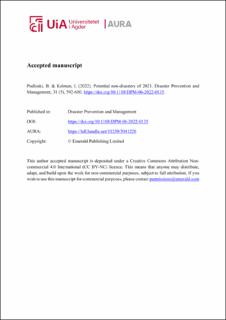| dc.contributor.author | Podloski, Brady | |
| dc.contributor.author | Kelman, Ilan | |
| dc.date.accessioned | 2023-01-05T12:12:12Z | |
| dc.date.available | 2023-01-05T12:12:12Z | |
| dc.date.created | 2022-11-13T13:10:43Z | |
| dc.date.issued | 2022 | |
| dc.identifier.citation | Podloski, B. & Kelman, I. (2022). Potential non-disasters of 2021. Disaster Prevention and Management, 31 (5), 592-600. | en_US |
| dc.identifier.issn | 1758-6100 | |
| dc.identifier.uri | https://hdl.handle.net/11250/3041220 | |
| dc.description | Author's accepted manuscript. | en_US |
| dc.description | This author accepted manuscript is deposited under a Creative Commons Attribution Non-commercial 4.0 International (CC BY-NC) licence. This means that anyone may distribute, adapt, and build upon the work for non-commercial purposes, subject to full attribution. If you wish to use this manuscript for commercial purposes, please contact permissions@emerald.com. | |
| dc.description.abstract | Purpose: This short paper compiles some potential disasters that might not have happened in 2021 even though a major hazard occurred. No definitive statements are made of what did or did not transpire in each instance. Instead, the material offers a pedagogical and communications approach, especially to encourage deeper investigation and critique into what are and are not labelled as disasters and non-disasters—and the consequences of this labelling.
Design/methodology/approach: This short paper adopts a subjective approach to describing situations in 2021 in which a hazard was evident, but a disaster might not have resulted. Brief explanations are provided with some evidence and reasoning, to be used in teaching and science communication for deeper examination, verification and critique.
Findings: Examples exist in which hazards could have become disasters, but disasters might not have manifested, ostensibly due to disaster risk reduction. Reaching firm conclusions about so-called “non-disasters” is less straightforward.
Originality/value: Many reports rank the seemingly worst disasters while research often compares a disaster investigated with the apparently worst disasters previously experienced. This short paper instead provides possible ways of teaching and communicating potential non-disasters. It offers an approach for applying lessons to encourage action on disaster risk reduction, while recognising challenges with the labels “non-disaster”, “success” and “positive news”. | |
| dc.language.iso | eng | en_US |
| dc.publisher | Emerald | en_US |
| dc.rights | Navngivelse-Ikkekommersiell 4.0 Internasjonal | * |
| dc.rights.uri | http://creativecommons.org/licenses/by-nc/4.0/deed.no | * |
| dc.title | Potential non-disasters of 2021 | en_US |
| dc.type | Journal article | en_US |
| dc.type | Peer reviewed | en_US |
| dc.description.version | publishedVersion | en_US |
| dc.rights.holder | © 2022 Emerald Publishing Limited | en_US |
| dc.source.pagenumber | 592-600 | en_US |
| dc.source.volume | 31 | en_US |
| dc.source.journal | Disaster Prevention and Management | en_US |
| dc.source.issue | 5 | en_US |
| dc.identifier.doi | https://doi.org/10.1108/DPM-06-2022-0135 | |
| dc.identifier.cristin | 2072944 | |
| cristin.qualitycode | 1 | |

